Re: The Artsakh war cronology
Defeats force Azerbaijan to declare state of emergency
Azerbaijani President Abulfaz Elchibey declared a 60-day state of emergency on 2 April and ordered the immediate mobilization of young men aged 18-27, according to the Los Angeles Times of 4 April. On 4 April Armenian forces backed by tanks and artillery launched a new offensive on the town of Fizuli, which is located a few miles outside Nagorno-Karabakh's south-east border. The office of the UN High Commissioner for Refugees in Geneva estimated on 6 April that tens of thousands of Azerbaijani civilians were fleeing from Kelbadzhar, and that many had died of cold, hunger, and exhaustion on the way, Reuters reported. -Liz Fuller
Responding to a request from Azerbaijani President Abulfaz Elchibey "to use all means at your disposal" to halt the Armenian offensive, Turkish Prime Minister Suleyman Demirel argued that Turkish military assistance to Azerbaijan "would solve nothing", as other nations would then aid Armenia. Turkey and Iran are reportedly in contact over the possibility of bringing pressure to bear on Armenia, according to a Turkish Foreign Ministry spokesman. On 10 April, Azerbaijani forces launched counterattacks against Armenian villages in the north-east and south-east of Nagorno-Karabakh; the Armenian Foreign Ministry protested at what it termed an Azerbaijani incursion into the Armenian raion of Kafan, near the Iranian border, on 10 April in which
eight Armenian troops were killed. Armenian forces continued the artillery bombardment of Fizuli, southeast of Nagorno-Karabakh An Armenian Defense Ministry spokesman charged on 16 April that Turkey was sending arms and troops to Azerbaijan via Nakhichevan, and hinted that Armenia might shoot down Turkish transport planes that crossed its air
space, On 17 April Azerbaijani forces launched a counter-offensive in Kelbadzhar and shot down an Armenian transport helicopter evacuating wounded troops from the north-east of Nagorno-Karabakh 93-05-05 Article: In compliance with last week's UN Security Council resolution, Armenian troops have begun to withdraw from the Kelbadzhar region of Azerbaijan which they occupied in late March Apparently ethnic Armenian fighters see the current paralysis of power in Baku as an opportunity to expand gains in the regions lying between Nagorno-Karabakh and Armenia 93-07-05 3,000 Armenian troops with armored vehicles
Armenian forces continued to advance on the town of Agdam just east of Nagorno-Karabakh
Armenian forces continued to advance on the town of Agdam just east of Nagorno-Karabakh, shelling Karabakh forces backed by tanks took the strategic town of Agdam on 23 July after street fighting in which up to 500-Azerbaijani soldiers were killed, Western agencies reported. A Karabakh Armenian spokesman told the Los Angeles Times (25 July) that the occupation of Agdam had been imperative as Azerbaijani artillery had used it as a base to shell the Karabakh capital, Stepanakert. The town of Fizuli, south-east of Nagorno-Karabakh, fell to Armenian forces on 18 June thousands of Azerbaijani refugeees from the current fighting are fleeing towards the Azerbaijani-Iranian frontier Armenian forces took the town of Dzhebrail, south of Nagorno-Karabakh and 14 kilometers from the Azerbaijani-Iranian frontier, during the night of 18-19 August, Western agencies reported. Iran would retaliate against Armenia if its peace and border security were threatened; and it suggested joint Iranian-Turkish military action in support of Azerbaijan 93-09-01 According to an Azerbaijani Defense Ministry source, Armenian forces are advancing on the town of Kubatli, 7 km from the Armenian border. In an apparent attempt to bring pressure to bear on the Armenian government, Iran has mounted large-scale military exercises near its frontier with Armenia 93-09-02 Speaking in Ankara, Turkish President Suleyman Demirel affirmed that Turkey would continue to provide Azerbaijan with material, moral and political support.
The towns of Kubatli, Zangelan and Goradiz in southeastern Azerbaijan were subjected to heavy artillery bombardment on 23-October, IRNA reported on 24 October. An Azerbaijani presidential spokesman claimed that troops from Armenia had launched an offensive against Goradiz, while Karabakh representatives in Stepanakert and Baku charged that the Azerbaijanis had attacked Gadrut raion in the south of Nagorno-Karabakh Armenian forces backed by tanks took the town of Zangelan on 29 October, inflicting heavy losses on the Azerbaijani defenders, Renewed fighting in the Beilagan raion of Nagorno-Karabakh on 11-12 December resulted in heavy casualties,
reported Interfax and ITAR-TASS. The Azerbaijani government and the Karabakh Armenian authorities have accused each other of beginning the new offensive. Both claim that the enemy lost up to 200 men plus armored vehicles or tanks in the fighting.
Article: Karabakh Armenian forces were forced to retreat on 28 December from mountain positions surrounding Agdam, east of Nagorno-Karabakh, following fierce fighting that resulted in heavy casualties on both sides, according to a Karabakh Armenian spokesman quoted by AFP. The spokesman attributed the Azerbaijani success to the presence
of Afghan mujahidin and to orders that Azerbaijani deserters from the front line be shot on the spot.
AZERBAIJAN SEEKS TO RECRUIT BRITISH MERCENARIES
Article: The Azerbaijani authorities are negotiating with a group of British and Turkish businessmen in an arms-and-mercenaries-for-oil deal which reportedly has the tacit support of the British government,
Defeats force Azerbaijan to declare state of emergency
Azerbaijani President Abulfaz Elchibey declared a 60-day state of emergency on 2 April and ordered the immediate mobilization of young men aged 18-27, according to the Los Angeles Times of 4 April. On 4 April Armenian forces backed by tanks and artillery launched a new offensive on the town of Fizuli, which is located a few miles outside Nagorno-Karabakh's south-east border. The office of the UN High Commissioner for Refugees in Geneva estimated on 6 April that tens of thousands of Azerbaijani civilians were fleeing from Kelbadzhar, and that many had died of cold, hunger, and exhaustion on the way, Reuters reported. -Liz Fuller
Responding to a request from Azerbaijani President Abulfaz Elchibey "to use all means at your disposal" to halt the Armenian offensive, Turkish Prime Minister Suleyman Demirel argued that Turkish military assistance to Azerbaijan "would solve nothing", as other nations would then aid Armenia. Turkey and Iran are reportedly in contact over the possibility of bringing pressure to bear on Armenia, according to a Turkish Foreign Ministry spokesman. On 10 April, Azerbaijani forces launched counterattacks against Armenian villages in the north-east and south-east of Nagorno-Karabakh; the Armenian Foreign Ministry protested at what it termed an Azerbaijani incursion into the Armenian raion of Kafan, near the Iranian border, on 10 April in which
eight Armenian troops were killed. Armenian forces continued the artillery bombardment of Fizuli, southeast of Nagorno-Karabakh An Armenian Defense Ministry spokesman charged on 16 April that Turkey was sending arms and troops to Azerbaijan via Nakhichevan, and hinted that Armenia might shoot down Turkish transport planes that crossed its air
space, On 17 April Azerbaijani forces launched a counter-offensive in Kelbadzhar and shot down an Armenian transport helicopter evacuating wounded troops from the north-east of Nagorno-Karabakh 93-05-05 Article: In compliance with last week's UN Security Council resolution, Armenian troops have begun to withdraw from the Kelbadzhar region of Azerbaijan which they occupied in late March Apparently ethnic Armenian fighters see the current paralysis of power in Baku as an opportunity to expand gains in the regions lying between Nagorno-Karabakh and Armenia 93-07-05 3,000 Armenian troops with armored vehicles
Armenian forces continued to advance on the town of Agdam just east of Nagorno-Karabakh
Armenian forces continued to advance on the town of Agdam just east of Nagorno-Karabakh, shelling Karabakh forces backed by tanks took the strategic town of Agdam on 23 July after street fighting in which up to 500-Azerbaijani soldiers were killed, Western agencies reported. A Karabakh Armenian spokesman told the Los Angeles Times (25 July) that the occupation of Agdam had been imperative as Azerbaijani artillery had used it as a base to shell the Karabakh capital, Stepanakert. The town of Fizuli, south-east of Nagorno-Karabakh, fell to Armenian forces on 18 June thousands of Azerbaijani refugeees from the current fighting are fleeing towards the Azerbaijani-Iranian frontier Armenian forces took the town of Dzhebrail, south of Nagorno-Karabakh and 14 kilometers from the Azerbaijani-Iranian frontier, during the night of 18-19 August, Western agencies reported. Iran would retaliate against Armenia if its peace and border security were threatened; and it suggested joint Iranian-Turkish military action in support of Azerbaijan 93-09-01 According to an Azerbaijani Defense Ministry source, Armenian forces are advancing on the town of Kubatli, 7 km from the Armenian border. In an apparent attempt to bring pressure to bear on the Armenian government, Iran has mounted large-scale military exercises near its frontier with Armenia 93-09-02 Speaking in Ankara, Turkish President Suleyman Demirel affirmed that Turkey would continue to provide Azerbaijan with material, moral and political support.
The towns of Kubatli, Zangelan and Goradiz in southeastern Azerbaijan were subjected to heavy artillery bombardment on 23-October, IRNA reported on 24 October. An Azerbaijani presidential spokesman claimed that troops from Armenia had launched an offensive against Goradiz, while Karabakh representatives in Stepanakert and Baku charged that the Azerbaijanis had attacked Gadrut raion in the south of Nagorno-Karabakh Armenian forces backed by tanks took the town of Zangelan on 29 October, inflicting heavy losses on the Azerbaijani defenders, Renewed fighting in the Beilagan raion of Nagorno-Karabakh on 11-12 December resulted in heavy casualties,
reported Interfax and ITAR-TASS. The Azerbaijani government and the Karabakh Armenian authorities have accused each other of beginning the new offensive. Both claim that the enemy lost up to 200 men plus armored vehicles or tanks in the fighting.
Article: Karabakh Armenian forces were forced to retreat on 28 December from mountain positions surrounding Agdam, east of Nagorno-Karabakh, following fierce fighting that resulted in heavy casualties on both sides, according to a Karabakh Armenian spokesman quoted by AFP. The spokesman attributed the Azerbaijani success to the presence
of Afghan mujahidin and to orders that Azerbaijani deserters from the front line be shot on the spot.
AZERBAIJAN SEEKS TO RECRUIT BRITISH MERCENARIES
Article: The Azerbaijani authorities are negotiating with a group of British and Turkish businessmen in an arms-and-mercenaries-for-oil deal which reportedly has the tacit support of the British government,


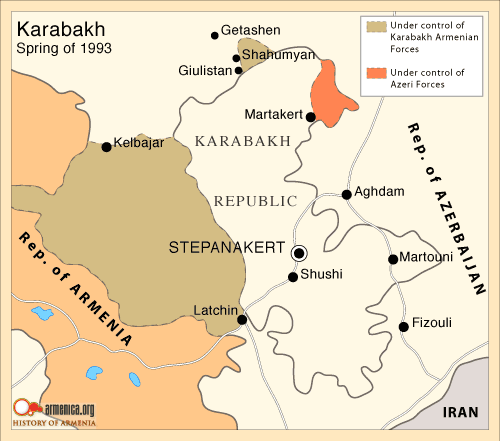
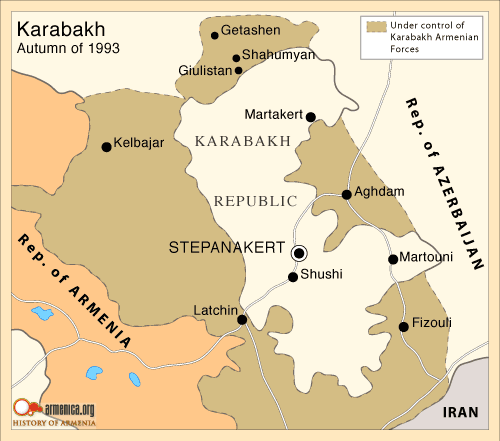



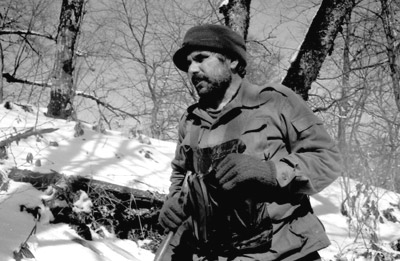


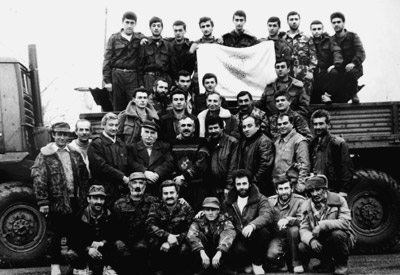

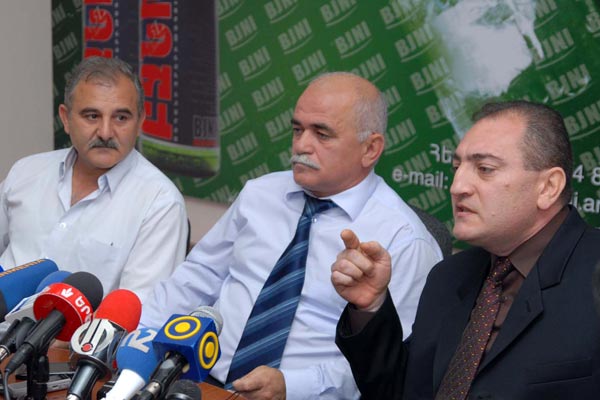

Comment